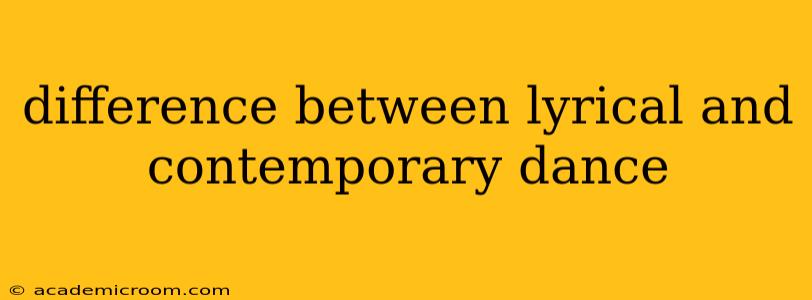The worlds of lyrical and contemporary dance are often intertwined, leading to confusion about their differences. While both styles emphasize expressive movement and emotional storytelling, key distinctions set them apart. This article delves into these differences, answering common questions to clarify the nuances between these captivating dance forms.
What is Lyrical Dance?
Lyrical dance is a style that blends ballet technique with the emotional expressiveness of modern dance. It's characterized by its fluid, graceful movements, often incorporating elements of jazz and contemporary dance. However, lyrical dance's defining feature is its strong connection to the music; the choreography directly reflects the lyrics and melody, creating a narrative driven by emotional storytelling. Think flowing, elegant movements that mirror the ebb and flow of the song's emotions.
What is Contemporary Dance?
Contemporary dance is a broad umbrella term encompassing a range of styles that emerged in the mid-20th century as a reaction against the limitations of ballet and modern dance. It borrows techniques from various styles—ballet, modern, jazz, even martial arts—and often incorporates improvisation and floor work. While emotion plays a significant role, contemporary dance is less strictly tied to lyrical content than lyrical dance. It focuses on exploring movement possibilities, expressing a wide range of emotions and concepts, often abstractly.
What are the Key Differences Between Lyrical and Contemporary Dance?
The core difference lies in the relationship between movement and music. In lyrical dance, the choreography directly interprets the lyrics and melody of the song. The movements tell the story of the song. Contemporary dance, while emotionally expressive, can be more abstract. The music might inspire the movement, but the choreography doesn't necessarily mirror the lyrics directly. It might explore a theme or feeling evoked by the music, but without a literal translation.
Movement Qualities:
- Lyrical Dance: Emphasizes fluidity, grace, elegance, and often incorporates softer, more flowing movements. Turns, leaps, and other ballet-derived techniques are common.
- Contemporary Dance: Uses a wider range of movement qualities, from sharp and angular to fluid and lyrical. It often incorporates floor work, contractions, releases, and more unconventional techniques.
Musicality:
- Lyrical Dance: Deeply connected to the lyrics and melody of the music. Every movement has a direct relationship to the song's emotional arc.
- Contemporary Dance: Music is often used as inspiration, but the choreography might not directly reflect the lyrics. It can be more abstract in its interpretation of the music.
Is Contemporary Dance Harder Than Lyrical Dance?
This is subjective. Both styles require significant dedication, strength, flexibility, and technical skill. Lyrical dance might emphasize ballet-based technique more heavily, while contemporary dance might demand greater flexibility and strength for floor work and unconventional movements. The “harder” style depends on an individual dancer’s strengths and weaknesses.
How Do I Choose Between Lyrical and Contemporary Dance?
The best choice depends on your personal preferences and goals. If you enjoy expressing emotions through fluid, graceful movements directly connected to music lyrics, lyrical dance might be a good fit. If you prefer a more explorative and abstract approach to movement and are interested in a wider range of techniques, contemporary dance may be more appealing. Consider trying introductory classes in both styles to discover which resonates more with you.
Can You Combine Lyrical and Contemporary Dance?
Absolutely! Many choreographers blend elements of both styles to create unique and expressive pieces. The lines between lyrical and contemporary dance are often blurred, and incorporating techniques from both styles allows for richer and more diverse movement vocabulary.
This exploration aims to clarify the often-blurred lines between lyrical and contemporary dance. While sharing a common thread of emotional expression through movement, their relationship to music and techniques create distinct and beautiful art forms.
